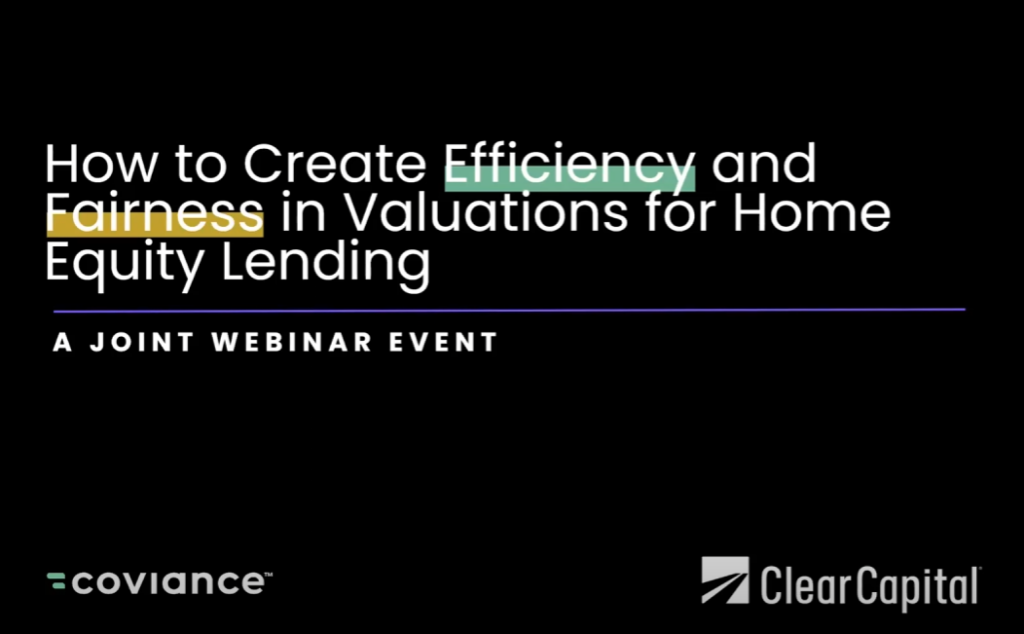This post is based on a recent webinar hosted by Coviance and Clear Capital. Watch the webinar here.
With American homeowners holding near-record amounts of equity, it’s a great time for lenders to diversify their offerings by providing homeowners with equity solutions, like HELOCs or closed-end second liens. But how can lenders originate home equity loans efficiently? This post will explore strategies to streamline the valuation process with innovative products designed to make valuations both fair and efficient, ensuring that borrowers receive the best possible service.
The typical home equity customer
Thanks to higher home prices, homeowners in the U.S. are sitting on roughly $33 trillion in equity, which is nearly double the $1.6 trillion in equity in 2018. That breaks down to an estimated $200,000 in tappable equity per homeowner. With mortgage rates still above 7% as of June 2024, refinancing is a less popular option for homeowners. Homeowners may instead opt for a home equity line of credit (HELOC). Analysis of Google search data reveals that search for HELOCs skyrocketed 305% in the U.S. as of July 2023 — the highest level in internet history in America.
Roadblocks to home equity lending
While there is much opportunity for lenders to help customers tap into their equity, there are several considerations that lenders must address before starting a home equity lending program:
- Competition — As the Google search data shows, homeowners are interested in tapping into their equity. If they can’t obtain a home equity loan from you, they’ll get it elsewhere. Many fintech companies offer and advertise same-day approvals for home equity loans.
- Regulation and compliance — Home equity lending is highly regulated to protect lending fairness. Financial institutions need to maintain an efficient process that meets compliance requirements and fair lending laws.
- Cost — Home equity lending typically incurs higher closing costs, the addition of pricy fees and reports can be discouraging to home equity consumers. Homeowners will likely review the all-in costs and seek the lowest price to access cash.
- Access — Consumers can access money more quickly and easily with credit cards or personal loans than they can through home equity loans. Enabling them to quickly access cash with lower interest rate debt options is paramount to meeting their needs.
Automated valuations for home equity: compliant, fast, and affordable
An automated valuation model (AVM) is a computer algorithm that produces an estimate of a property’s value. AVMs incorporate nearby real estate data — including recent sale prices, characteristics, and features of nearby properties — and feed that data to algorithms to generate an estimate of a home’s value. Automated valuations are available much more quickly than other traditional valuations. As there is no human processing involved, automated valuations are also not impacted by subjective assessments of value. AVMs comply with the same regulations that all other valuations must comply with and come at a much lower cost that doesn’t hurt the bottom line for originators or consumers.
Each AVM on the market is built upon a certain set of data and each with its own calculation method. This creates a lack of standardization and varying levels of AVM quality. We can classify an AVM as either marketing-grade or lending-grade.
Marketing-grade AVMs are typically public-facing, designed to pique the interest of potential borrowers, and are useful for sales lead generation. Lending-grade AVMs are typically business-facing, designed for situations that require highly precise results, and are used by financial institutions. Lending-grade AVMs will give potential borrowers a better, more realistic idea of the value of their home and what type of home equity loan may be best for them. The quality of ClearAVM’s data and the breadth of the property data we use, the frequency with which that data is updated, and the rigor with which the AVM is tested and fine tuned make it a trusted lending-grade AVM.
Make reliable home equity offers to existing loan customers with a lending grade AVM
Lenders can use an AVM to create targeted messaging to existing customers. A lender may want to review their list of existing customers and obtain an updated home value for each customer home loan. Then, using the AVM and the outstanding mortgage principal, lenders can calculate homeowner equity. Using a highly accurate lending-grade AVM, lenders can provide an accurate estimate of tappable equity for each customer.
The benefit of using a lending-grade AVM during this process is that lenders are able to present a more reliable offer to customers, and customers may be more likely to convert because the initial valuation may be the same valuation as underwriting since AVM may be used as the primary valuation in Home equity origination.
Test the most trusted lending-grade AVM on the market
Clear Capital’s ClearAVM is one of the industry’s most trusted lending-grade AVMs. The ClearAVM PDF report can include property imagery, map views, property value estimates, comparables, and more. The report also features a Confidence Score that predicts Clear Capital’s confidence in the valuation based on forecast standard deviation.
You can test up to 100,000 ClearAVMs against your own valuations for free. Simply gather your benchmark values and our team will work with you to submit the addresses and dates for valuation. You’ll receive and can analyze the results, measure the difference between the benchmark value and the ClearAVM, and review the correlation of the two with our Confidence Score. Email sales@clearcapital.com for more information.


